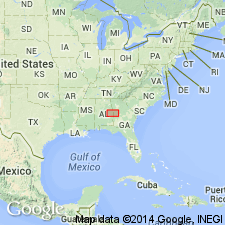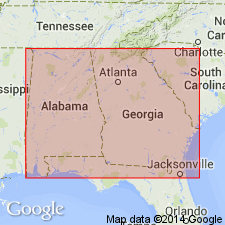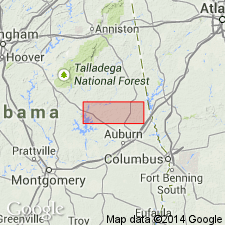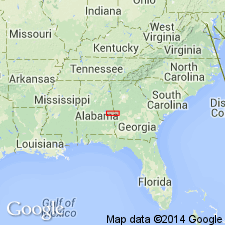
- Usage in publication:
-
- Dadeville Complex
- Modifications:
-
- Named
- Dominant lithology:
-
- Granite
- Schist
- Amphibolite
- AAPG geologic province:
-
- Piedmont-Blue Ridge province
Summary:
Dadeville Complex named for town of Dadeville, AL. Occurs east-central AL and west-central GA. Includes Waresville Formation, Agricola Schist-Gneiss, Rock Mills Granite, Camp Hill Granite, Ropes Creek Amphibolite, Smith Mountain Peridotite, and Boyds Creek Amphibolite. Age is early Paleozoic.
Source: GNU records (USGS DDS-6; Reston GNULEX).

- Usage in publication:
-
- Dadeville Complex
- Modifications:
-
- Age modified
- Geochronologic dating
- AAPG geologic province:
-
- Piedmont-Blue Ridge province
Summary:
Dadeville Complex intruded by the informally named Franklin gneiss, a metamorphosed and deformed batholith-scale granite pluton with abundant outcrops in Heard Co., west-central GA. An Rb-Sr whole rock age of 462+/-4 Ma (Middle Ordovician) on the Franklin provides a minimum age constraint for Dadeville rocks.
Source: GNU records (USGS DDS-6; Reston GNULEX).

- Usage in publication:
-
- Dadeville Complex
- Modifications:
-
- Revised
- AAPG geologic province:
-
- Piedmont-Blue Ridge province
Summary:
Dadeville Complex in study area is divided into Agricola Schist, Waverly Gneiss, Waresville Schist, unnamed mafic intrusives, Camp Hill Gneiss (redefined), Chattasofka Creek Gneiss (named), Simmons Crossroads metagranite (informally named), and ultramafic intrusives. Age of the Dadeville is extended into the middle Paleozoic as the intrusive Camp Hill and Chattasofka Creek probably represent the beginning of the Acadian Orogeny.
Source: GNU records (USGS DDS-6; Reston GNULEX).

- Usage in publication:
-
- Dadeville Complex*
- Modifications:
-
- Age modified
- AAPG geologic province:
-
- Piedmont-Blue Ridge province
Summary:
Inner Piedmont is divided into two groups of rocks, Dadeville and Opelika Complexes (Bentley and Neathery, 1970), divided by Stonewall line. Dadeville Complex consists of Agricola Schist, Waresville Schist, Camp Hill Gneiss, Chattasofka Creek Gneiss, Ropes Creek Amphibolite, Waverly Gneiss, Simmons Crossroads metagranite (informal), and various unnamed mafic and ultramafic intrusive rocks. Opelika Complex consists of Loachapoka Schist, Saugahatchee quartzite, and Auburn Gneiss and schist. Farmville Metagranite intrudes these units. Age of all Inner Piedmont rocks is early Paleozoic. Report includes geologic sketch map.
[Remark reflects usage as published, not as reviewed in draft form. Although GNU review requested informal terms to be inverted, the published version shows that authors did not comply with request. Whatley Mill is misspelled as Whatley Mills in published version; error introduced after GNU review (GNU records, USGS DDS-6; Reston GNULEX 01/21/94).]
Source: GNU records (USGS DDS-6; Reston GNULEX).
For more information, please contact Nancy Stamm, Geologic Names Committee Secretary.
Asterisk (*) indicates published by U.S. Geological Survey authors.
"No current usage" (†) implies that a name has been abandoned or has fallen into disuse. Former usage and, if known, replacement name given in parentheses ( ).
Slash (/) indicates name conflicts with nomenclatural guidelines (CSN, 1933; ACSN, 1961, 1970; NACSN, 1983, 2005, 2021). May be explained within brackets ([ ]).

